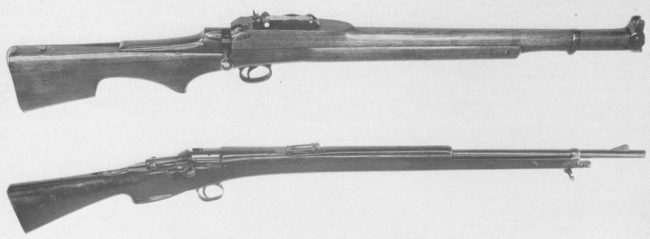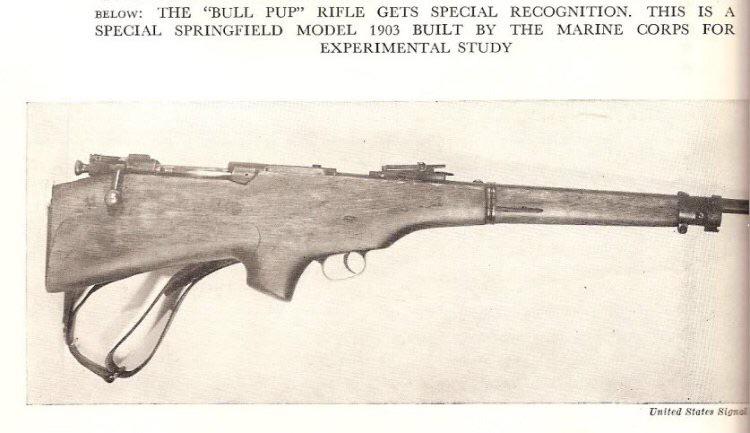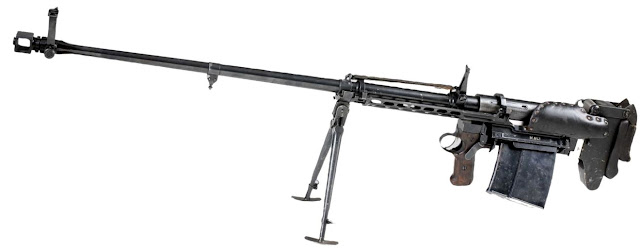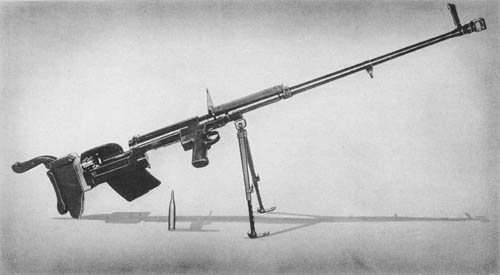Bullpup history, part 1
-
All texts are written by Maxim Popenker © 1999-2022 admin@ modernfirearms.net
-
Collapse all
By Maxim Popenker
Traditionally, bullpup configuration of the weapon means that its trigger and grip for a firing hand are located in front of the breech area of the gun. This normally means that bolt, magazine and other necessary mechanisms are located behind the trigger and, usually, inside or above the shoulder stock. This configuration, compared with traditional “long gun” layout, offers obvious advantages of shorter overall length and better balance; disadvantages are more awkward procedures of reloading magazines, problems with left-hand shooting and placement of the chamber area very close to the shooter’s face.
Bullpup configuration of the rifle became possible and feasible only with introduction of the self-contained cartridge case, with ignition system contained inside the action of the gun. One of the first known designs of bullpup rifle was patented in UK in around 1902, by a Scottish man J.B.Thorneycroft. His intent was to provide a rifle with compact size, which, at the same time, retains barrel length and effective range of a conventional, full-size military rifle. To achieve this effect, Thorneycroft moved the action and magazine rearward, into the shoulder stock, and placed trigger in front of a magazine. He also provided a necessary long link between the trigger and the sear, which ran inside the stock around the magazine. Thorneycroft rifle was tested by British army in several versions, but was finally rejected in favor of a “rifle, short, magazine, Lee-Enfield”, or SMLE in short, which was of traditional layout. At about the same time, another British inventor, P.T.Godsal, patented his own version of the bullpup bolt action rifle, which, despite numerous later improvements, also failed to attract any military or civilian buyers.
Thorneyecroft (top) and Godsal (bottom) bullpup rifles, from around 1905
patent diagram for Thorneycroft bullpup rifle
demonstration of the employment of the French experimental Faucon bullpup rifle (1911)
In 1910, French designer A.F. Faucon applied for a patent for “Fusil équilibré”, or a “balanced rifle”. In his design, Faucon sought to provide a semi-automatic rifle which would decrease the strain on the shooter when firing from walking, standing or kneeling position, by putting most of the gun’s weight onto the shoulder rather than hands. The shoulder stock was located below the gun, in front of the magazine and action, as to balance the gun on the shoulder; trigger and pistol grip were further to the front. It was a rather advanced weapon, and, like many others, was well ahead of its time. It must be noted that the rifle itself was designed by Meunier; Faucon only re-configured it to the over-the-shoulder bullpup layout.
diagram from patent issued to Faucon for his “balanced rifle” (1911)
First World War (or “the war to end all wars”, as it was optimistically called at the time) spurred development of automatic firearms, especially those suited for maneuvered warfare. As early as 1918, at least two interesting bullpup designs were patented in USA.
diagrams from patent, issued to Fordyce for his work on bullpup machine guns (1918)
The first one started with fairy conventional and well-known Lewis machine gun. Someone J.R.Fordyce began with the same concept that previously was pursued by Faucon; he tried to make Lewis light machine guns (which, in fact, weren’t that light) to be more convenient to use from standing position or on the move. The simplest way to achieve this was to put the standard gun over the shoulder, by adding two grips and a front trigger below the barrel. Next step was to dispense with the wooden stock to lighten the gun and make it more compact, and add a shoulder loop to support weapon in its “battle-ready” position. Final, most elaborate design involved specially designed gun, with conveyor-type feed system that held cartridges perpendicular to the barrel and rotated them before loading; in some respects, this pre-dated Belgian FN P90 feed system by more than 60 years. To achieve better balance, the gun was to be carried under the armpit, held in balance by the loop, placed around the shoulder of the shooter. Pistol grip and trigger were to be located well at the front. It is not known, if Fordyce ever produced a gun to this final design, but his simple conversion of the Lewis MG into improvised bullpup seems quite feasible.
Second bullpup from the year of 1918 was also of American design. Patented by H.L.Welsh, it looked like a stretched semi-automatic pistol, with magazine located in the hump at the rear and pistol grip and trigger moved forward. The concept of this weapon, according to the inventor, was to provide better control over the recoil of handguns, by transferring most of it from the wrist to the bicep, and to put most of the weight of the gun from the palm and wrist area to the stronger forearm part of the hand. This, as per patent text, would allow for better accuracy and faster follow-up shots. Again, it is not known if this weapon ever existed ‘in the flesh’, but its concept lived on.
diagram from Welsh patent for his bullpup pistol (1918)
Americans seemed quite fascinated with bullpups at the time, as in 1920 US Army sergeant P.B.Cunningham received a patent for what he called simply a “military rifle”. In fact, his design was quite advanced for its time. It was a gas operated semi-automatic rifle with rotary bolt locking and a large capacity magazine (stated capacity about 20 cartridges). Most important to us is the fact that Cunningham’s rifle was designed in bullpup layout, with magazine located inside the shoulder stock, and trigger in the front. It also has unusual stock with a large horizontal opening (window) near the top of the shoulder stock. Apparently, it was there to provide a solid grip for bayonet thrusts.
patent diagram showing layout of the Cunningham’s “military rifle” (1920)
diagrams from patent of H.Delacre, showing his concept of bullpup submachine gun (1937)
In 1936, someone H.Delacre, a Frenchman, received a British patent for “Improvements in portable firearms, pistol or revolver type”. His design seemed to be a direct descendant of the American Welsh bullpup pistol from 1918. In pursuit of same goals (better accuracy when firing with one hand), Delacre proposed a compact weapon, which, according to the patent drawings, looked like a compact submachine gun with dual triggers. Again, it is not known if this gun ever existed “in the flesh” (or, rather, “in the steel”), but this particular patent became well-known and was mentioned in more than one later invention of the same nature.
Toward the end of the ninety thirties, another nation got a healthy interest in bullpup weapons. This time it was Czechoslovakia, whose designers worked on a variety of anti-tank rifles in calibers between 7.9 and 15 mm. Anti-tank warfare dictates high velocities, especially for small-caliber projectiles, and this, in turn, requires long barrels and even longer guns. To save some of the excessive length and to mage guns a little bit more maneuverable and lighter, Czechoslovak designers reverted to bullpup layout. Several prototype weapons were built starting around 1938, and this work resulted in development of the first bullpup weapon to be actually adopted by any military force in the world. It was the Panzerbuhse M.SS.41, a manually operated bolt action rifle firing powerful 7.92×94 ammunition of German origin. Manufactured for German Waffen-SS forces in occupied Czechoslovakia, it was based on pre-war experimental designs such as 7.92x145mm ZK-382. Chief designers for these weapons, developed and manufactured in Brno, were famous Holek brothers. PzB M.SS.41 was hardly a successful weapon, because even in 1941 the 7.92mm high velocity bullets were greatly insufficient to defeat allied tanks. However, this gun is historically important because it was first bullpup ever to enter military service. Soviet designers also worked on several experimental bullpup anti-tank rifles during late 1930s, but none went beyond prototype status.
experimental Czechoslovak ZK-382 anti-tank rifle (1938)
experimental Soviet anti-tank rifle by Bloom (1937)
As the World War 2 rolled across the Europe, a lot of people run away from Nazi armies that occupied their native countries. As a result, many experienced firearms designers ended up across the Channel, in the UK. It is not known if it were those continental designers who re-introduced idea of bullput to British minds, or they kept it somewhere nearby all the time, but several interesting bullpup designs appeared in UK during the war. Probably most known of these was the 7.9mm EM-1 automatic rifle, developed by Polish refugee named Korsac. Mechanically, Korsac rifle was greatly reminiscent of the German FG-42 rifle, including 7.92×57 Mauser ammo it used, except that Korsac rifle was of proper bullpup layout, and featured quickly removable barrel. At least one specimen of the Korsac automatic rifle survived to this day in UK.
British 7.92x57mm EM-1 automatic rifle, developed by polish refugee Korsac (1944)
Two less known designs were built toward the end of the war in attempt to create a compact and fast-shooting sniper rifle. One design, known as SREM-1 (Sniper Rifle, Experimental Model 1), was a manually operated weapon, with action cycled through movable pistol grip. Another, known as the Hall rifle, was a gas-operated semi-automatic weapon which, as it appears, was one of the first to address one most important deficiency of most bullpup designs – ejection. Due to close proximity of the chamber to the shooter’s face, conventional top- or side-ejection makes left-hand shooting either impossible or very uncomfortable. In his design Hall solved this issue by making his weapon ejecting rearwards, through an ejection chute, located above the shoulder of the shooter. Neither SREM-1 nor Hall rifle went beyond prototype stage, and it took British industry several post-war years to produce a truly worthy bulpup military rifle. But this story will be discussed in the next article.
SREM-1 manually operated experimental bullpup sniper rifle (1944)
diagram from patent, showing internal layout of the Hall semi-automatic bullpup sniper rifle (1944)
















